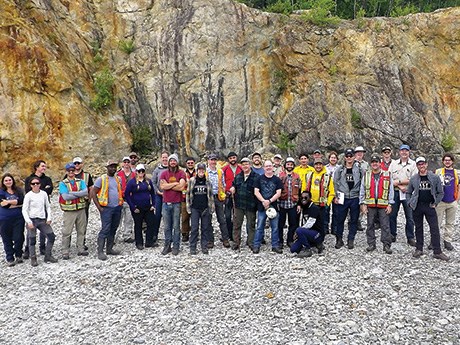Probing the secrets of the Superior Craton
Metal Earth, the $104 million geoscience research program co-ordinated by the Harquail School of Earth Sciences’ Mineral Exploration Research Centre at Laurentian University, plans to begin releasing data this year.
The primary objective of the research program “is to understand the factors that control differential metal endowment” in Canada’s Superior Craton, a block of Archean rock that extends across Quebec, Northern Ontario and Manitoba, said Ross Sherlock, director of both MERC and Metal Earth.
“If you look at the map of the Abitibi Region, for example, gold and base metals are not universally distributed throughout the area although the geology is very similar. (The metal) clusters and we’re trying to find out what controls that clustering.”
In 2017, Metal Earth commissioned a number of seismic surveys using vibrator trucks with two-tonne pressure plates to measure sound waves reflected back to surface. Surveys were completed across 13 Greenstone Belt transects in Quebec and Ontario covering a total of 1,070 kilometres.
“Each selected transect crossed an ancestral fault system or ancestral volcanic centre that had a variable degree of metal endowment,” said Sherlock. “Some had a lot of metal. Some had very little, and what we’re trying to do is understand the difference between them.”
Most of the surveys were performed at R1 mode capturing data from 33 to 48 kilometres below surface. However, in areas of particular interest, higher resolution R2 mode surveys were performed down to 10 kilometres to provide much more detail.
The seismic surveys offer geoscientists some idea of the architecture of the crust, but on their own, data from the seismic surveys is not really that informative, said Sherlock. It needs to be combined with other data and interpreted.
Most of the seismic survey data was processed in time for fieldwork in 2018 that included geological mapping and magnetic telluric surveys, which measure the conductivity or resistivity of the crust.
Fieldwork on four transects was completed in 2018 and additional geological mapping was done in Cobalt, Geraldton-Onamin and Dryden. Work will continue this year on more transects over Greenstone Belts and areas of interest in Atikokan, Rainy River and Sturgeon in northwestern Ontario. A final year of fieldwork will be carried out in 2020 following which Metal Earth research associates will have a year to write their reports.
Several PhD students are also working on thematic studies focusing on “special problems that we’re trying to understand,” said Sherlock. “We have one PhD student working on the potential for Archean porphyry deposits, and another student working on the Kapuskasing Structural Zone and gold around Borden Lake.”
The Metal Earth research program includes 13 post docs or research associates, nine PhD students, 22 Masters students, plus administrative staff and technicians. While led by MERC and Laurentian University’s Harquail School of Earth Science, the program has partnerships with five universities: the University of Chicoutimi, Université Laval, the University of Toronto, Ottawa University and the University of Alberta, all of which have post docs and graduate students working on Metal Earth.
The Canadian government’s Canada First Research Excellence Fund contributed $49.2 million for Metal Earth. The remainder of the $104 million research program is made up of cash and in-kind services from Laurentian University, the geological surveys of Canada, Quebec and Ontario, the Northern Ontario Heritage Fund, David Harquail and several mining companies.
Sherlock cautions that “geologists won’t be able to take our data and target a drill hole. We’re.… helping people understand the larger scale processes and controls on mineralization within these Greenstone Belts.”
Industry appears to be eager to learn from Metal Earth’s research.
“In the fall, after our fieldwork, we run field trips open to the public,” said Sherlock. “We’ll take anybody who wants to show up. It’s free. We’ll show them the geophysics and our interpretations and ideas. We had seven field trips last year and 174 people showed up, including representatives from industry, government and academia.
“We’re starting to get multiple layers of datasets along individual transects and the results are interesting. We’re starting to see similarities and differences, but it’s a bit premature to start saying this is why this Greenstone Belt has a lot of metal and this one doesn’t.”
Anyone interested in updates from Metal Earth is welcome to subscribe to its newsletter at www.merc.laurentian.ca



.jpg;w=120;h=80;mode=crop)